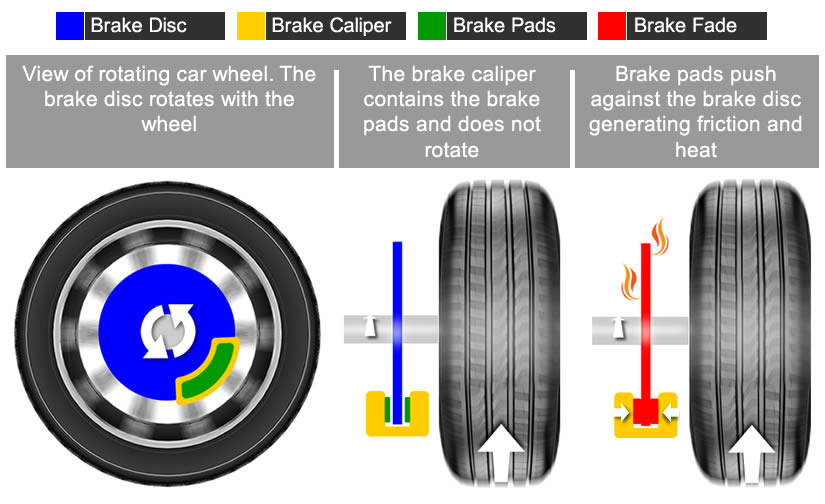Brake Fade Explained
The most common type of brake fade is ‘friction fade’ and it’s the temporary reduction in braking ability by the vehicle’s braking system. Brake fade occurs due to a reduction of friction between the brake pads and brake disc and can result in a partial loss or total loss of braking ability.
How Does Brake Fade Occur?
Your car’s braking system works by pushing brake pads that are contained in the brake caliper onto a brake disc that is rotating with the car wheels. This process produces friction.
Motion, or in this instance Kinetic energy, by use of friction is therefore converted into heat. If the desired reduction in speed is achieved either by braking hard and slowing the vehicle rapidly or by applying the brakes lightly over a longer period of time, the same amount of heat is generated. This is because a specific amount of energy must be converted to achieve the desired objective.
Brake pads and discs are designed to be usable up to a certain temperature. This temperature varies depending on the type of pads and discs fitted to a vehicle, but on most cars, ‘normal’ driving will see temperatures of between 100°C and 200°C being perfectly workable.
Most normal brake pads are metallic based, being made from metal shavings and being bonded together by a resin. Brake fade occurs when the resin begins to vaporise due to high temperatures and forms a film between the pad and disc. For some brake pads, brake fade can occur at temperatures as low as 300°C.
Brake fade can also occur when the brake fluid boils. This is where heat is transferred from the brakes to the fluid and boils it. In this instance, the brake pedal will feel spongy when you press it and you’ll need to press it much harder to achieve the same level of braking. As brake fluid ages, it absorbs contaminants and water making it less efficient and less able to deal with heat. It’s advised that you change your brake fluid every two years.
How Long Does Brake Fade Last?
Due to brake fade being the result of overheating brake pads and disc, how long brake fade lasts depends on how long it takes for the brake system to cool down.
Is Brake Fade Permanent?
Brake fade itself only lasts for as long as the brakes are attempting to operate outside of their workable temperature range. However, the affects or damage caused by brake fade can be permanent. Brake discs can become warped and require replacement. If after brake fade has occurred and your vehicle’s ability to slow appears less effective than it was prior to brake fade, it could be due to a film of resin covering the pads. In this instance, the pads may require sanding.
How to Prevent Brake Fade
Brake fade occurs due to overheating of the braking system. Under normal driving conditions, brake fade is unlikely to occur. So to try and prevent it, you should be aware of the circumstances in which it may develop, these include:
- Using cheap, untested brake components.
- Improperly fitted brake components.
- ‘Riding the brakes’ – this is where you’re driving with your foot on the brake pedal partially engaging the brakes.
- Running a vehicle with old brake fluid in the system.
- Driving at excessive speeds with heavy brake use.
- If your vehicle is carrying or towing a heavy load.
- Descending a long, steep hill (brake fade becomes increasingly likely if you’re carrying or towing extra weight).
Your car brakes have a tough job and over time require maintenance and replacement. Due to how important they are, it’s best to pay a little more and use good quality components.
How you drive also affects the lifespan and effectiveness of your braking system. Unless you drive a high performance vehicle, it’s likely you’ll have normal semi-metallic brake pads with normal (non-ventilated) brake discs. These are not designed for heavy brake use.
Always anticipate the road ahead and ease off the accelerator in good time so to ease the burden on the brakes. If going down a long slope, moderate your speed by engine braking and using the gears to reduce your speed, rather than relying only on the brakes. This is particularly important if you’re towing or carrying extra weight. Where possible, momentarily remove your foot from the brake pedal to allow the brakes a moment to cool.
What to do if My Car has Brake Fade
If you’re driving a manual, the first thing you need to do it change down a gear. Avoid panicking and changing into too lower gear for the speed of the vehicle as you may risk damaging the engine.
If you’re driving a semi-automatic, switch to manual mode and change down gears. If your vehicle is fully automatic, you should switch to a lower gear. These are often marked by ‘L’ or 1, 2, 3 or if you have a ‘+’ and ‘-‘, switch to the minus symbol.
To avoid colliding with other vehicles, look for escape routes. A grass verge will slow your vehicle faster.

excellent article but it is missing steering control